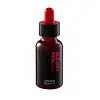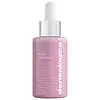What's inside
What's inside
 Key Ingredients
Key Ingredients

 Benefits
Benefits

 Concerns
Concerns

 Ingredients Side-by-side
Ingredients Side-by-side

Water
Skin ConditioningGlycolic Acid 8%
BufferingButylene Glycol
HumectantGlycerin
Humectant1,2-Hexanediol
Skin ConditioningNiacinamide
SmoothingPotassium Hydroxide
BufferingXanthan Gum
EmulsifyingGardenia Florida Fruit Extract
Skin ConditioningDextrin
AbsorbentSalicylic Acid
MaskingGluconolactone
Skin ConditioningTheobroma Cacao Extract
Skin ConditioningPropanediol
SolventEthylhexylglycerin
Skin ConditioningDisodium EDTA
Sodium Hyaluronate
HumectantCapryloyl Salicylic Acid
ExfoliatingAloe Barbadensis Leaf Extract
EmollientMalus Domestica Fruit Extract
AntioxidantBeta Vulgaris Root Extract
Skin ConditioningVaccinium Macrocarpon Fruit Extract
AstringentSolanum Lycopersicum Fruit Extract
AntioxidantRubus Idaeus Fruit Extract
AstringentPunica Granatum Fruit Extract
AntioxidantMalpighia Emarginata Fruit Extract
Skin ConditioningCapsicum Annuum Fruit Extract
AntimicrobialDaucus Carota Sativa Root Extract
Skin ConditioningHippophae Rhamnoides Fruit Juice
Skin ConditioningMaltodextrin
AbsorbentHydrolyzed Pea Protein
EmollientPhytosterols
Skin ConditioningSqualane
EmollientOlea Europaea Fruit Oil
MaskingLecithin
EmollientCeramide NP
Skin ConditioningCaprylyl Glycol
EmollientButyrospermum Parkii Butter
Skin ConditioningWater, Glycolic Acid 8%, Butylene Glycol, Glycerin, 1,2-Hexanediol, Niacinamide, Potassium Hydroxide, Xanthan Gum, Gardenia Florida Fruit Extract, Dextrin, Salicylic Acid, Gluconolactone, Theobroma Cacao Extract, Propanediol, Ethylhexylglycerin, Disodium EDTA, Sodium Hyaluronate, Capryloyl Salicylic Acid, Aloe Barbadensis Leaf Extract, Malus Domestica Fruit Extract, Beta Vulgaris Root Extract, Vaccinium Macrocarpon Fruit Extract, Solanum Lycopersicum Fruit Extract, Rubus Idaeus Fruit Extract, Punica Granatum Fruit Extract, Malpighia Emarginata Fruit Extract, Capsicum Annuum Fruit Extract, Daucus Carota Sativa Root Extract, Hippophae Rhamnoides Fruit Juice, Maltodextrin, Hydrolyzed Pea Protein, Phytosterols, Squalane, Olea Europaea Fruit Oil, Lecithin, Ceramide NP, Caprylyl Glycol, Butyrospermum Parkii Butter
Water
Skin ConditioningLactobacillus/Punica Granatum Fruit Ferment Extract
Skin ConditioningGlycolic Acid
BufferingAminomethyl Propanol
BufferingPhytic Acid
Gluconolactone
Skin ConditioningGlycerin
HumectantPropanediol
SolventLactic Acid
BufferingSalicylic Acid
MaskingTranexamic Acid
AstringentHydroxyacetophenone
AntioxidantSodium Hyaluronate
HumectantHydrolyzed Gardenia Florida Extract
AntioxidantZanthoxylum Bungeanum Fruit Extract
Skin ConditioningVaccinium Macrocarpon Fruit Extract
AstringentHelianthus Annuus Seed Oil
EmollientCitrus Aurantium Bergamia Fruit Oil
MaskingCitrus Nobilis Peel Oil
MaskingLeuconostoc/Radish Root Ferment Filtrate
AntimicrobialRaspberry Ketone
MaskingRosa Damascena Flower
Skin ConditioningSodium PCA
HumectantSucrose Distearate
EmollientSuccinoglycan
Skin ConditioningUrea
BufferingCeramide NP
Skin ConditioningPhytosphingosine
Skin ConditioningHydrogenated Lecithin
EmulsifyingCaprylyl Glycol
EmollientOleyl Alcohol
EmollientTriolein
Skin ConditioningCaprylic/Capric Triglyceride
MaskingOleic Acid
EmollientEthoxydiglycol
HumectantCholesterol
EmollientTrehalose
HumectantPolyquaternium-51
Skin ConditioningMaltodextrin
AbsorbentEthyl Acetate
PerfumingCaprylhydroxamic Acid
1,2-Hexanediol
Skin ConditioningPolyacrylate Crosspolymer-6
Emulsion StabilisingStearic Acid
CleansingGamma-Undecalactone
PerfumingWater, Lactobacillus/Punica Granatum Fruit Ferment Extract, Glycolic Acid, Aminomethyl Propanol, Phytic Acid, Gluconolactone, Glycerin, Propanediol, Lactic Acid, Salicylic Acid, Tranexamic Acid, Hydroxyacetophenone, Sodium Hyaluronate, Hydrolyzed Gardenia Florida Extract, Zanthoxylum Bungeanum Fruit Extract, Vaccinium Macrocarpon Fruit Extract, Helianthus Annuus Seed Oil, Citrus Aurantium Bergamia Fruit Oil, Citrus Nobilis Peel Oil, Leuconostoc/Radish Root Ferment Filtrate, Raspberry Ketone, Rosa Damascena Flower, Sodium PCA, Sucrose Distearate, Succinoglycan, Urea, Ceramide NP, Phytosphingosine, Hydrogenated Lecithin, Caprylyl Glycol, Oleyl Alcohol, Triolein, Caprylic/Capric Triglyceride, Oleic Acid, Ethoxydiglycol, Cholesterol, Trehalose, Polyquaternium-51, Maltodextrin, Ethyl Acetate, Caprylhydroxamic Acid, 1,2-Hexanediol, Polyacrylate Crosspolymer-6, Stearic Acid, Gamma-Undecalactone
 Reviews
Reviews

Ingredients Explained
These ingredients are found in both products.
Ingredients higher up in an ingredient list are typically present in a larger amount.
1,2-Hexanediol is a synthetic liquid and another multi-functional powerhouse.
It is a:
- Humectant, drawing moisture into the skin
- Emollient, helping to soften skin
- Solvent, dispersing and stabilizing formulas
- Preservative booster, enhancing the antimicrobial activity of other preservatives
Caprylyl Glycol is a humectant and emollient, meaning it attracts and preserves moisture.
It is a common ingredient in many products, especially those designed to hydrate skin. The primary benefits are retaining moisture, skin softening, and promoting a healthy skin barrier.
Though Caprylyl Glycol is an alcohol derived from fatty acids, it is not the kind that can dry out skin.
This ingredient is also used as a preservative to extend the life of products. It has slight antimicrobial properties.
Learn more about Caprylyl GlycolCeramide NP is a type of ceramide and formally known as ceramide 3.
Ceramides are intercellular lipids naturally found in our skin that bonds dead skin cells together to create a barrier. They are known for their ability to hold water and thus are a great ingredient for dry skin.
Ceramides are an important building block for our skin barrier. A stronger barrier helps the skin look more firm and hydrated. By bolstering the skin ceramides act as a barrier against irritating ingredients. This can help with inflammation as well.
If you would like to eat ceramides, sweet potatoes contain a small amount.
Read more about other common types of ceramides here:
Ceramide AP
Ceramide EOP
Gluconolactone is a PHA. PHAs are a great gentle alternative to traditional AHAs.
When applied, Gluconolactone has the same affect on skin as AHAs such as lactic acid. It helps dissolve the dead skin cells in the top layer of your skin. This improves texture and brightens the skin.
PHAs are more gentle than AHAs due to their larger structure. They do not penetrate as deeply as AHAs and take a longer time to dissolve dead cells. Studies show PHAs do not cause as much irritation.
Gluconolactone has some interesting properties:
In a 2004 study, Gluconolactone was found to prevent UV damage in mouse skin cells and has not been found to increase sun sensitivity. However, we still recommend wearing SPF daily.
This ingredient is is an created by reacting gluconic acid with an alcohol.
Learn more about GluconolactoneGlycerin is already naturally found in your skin. It helps moisturize and protect your skin.
A study from 2016 found glycerin to be more effective as a humectant than AHAs and hyaluronic acid.
As a humectant, it helps the skin stay hydrated by pulling moisture to your skin. The low molecular weight of glycerin allows it to pull moisture into the deeper layers of your skin.
Hydrated skin improves your skin barrier; Your skin barrier helps protect against irritants and bacteria.
Glycerin has also been found to have antimicrobial and antiviral properties. Due to these properties, glycerin is often used in wound and burn treatments.
In cosmetics, glycerin is usually derived from plants such as soybean or palm. However, it can also be sourced from animals, such as tallow or animal fat.
This ingredient is organic, colorless, odorless, and non-toxic.
Glycerin is the name for this ingredient in American English. British English uses Glycerol/Glycerine.
Learn more about GlycerinGlycolic Acid is arguably the most famous alpha hydroxy acid (AHA) with tons of research backing its benefits.
It is found naturally in sugar cane but the form used in skincare is usually synthetic for purity and stability.
Glycolic acid removes the top layer of dead skin cells to allow newer and fresher ones to emerge.
AHAs work by breaking down the structural “glue” that holds old skin cells in place. When that buildup is gone, your skin can renew itself more efficiently.
Research also shows glycolic acid stimulates collagen production, helping to firm and thicken the skin over time. This is one of its biggest advantages over other AHAs.
Overall, glycolic acid helps with:
Fun fact: Glycolic acid boosts skin hydration by helping it produce molecules that increase hyaluronic acid naturally.
To work best, glycolic acid products should have a pH between 3-4 (that’s where exfoliation is most effective but still gentle on skin).
The pH and concentration of a product are key to its effectiveness:
It is normal to feel a slight stinging sensation when using glycolic acid. This usually fades as your skin adjusts.
Because glycolic acid has the smallest molecular size in the AHA family, it can penetrate deeper, which enhances its effectiveness but also makes it more likely to irritate sensitive skin.
If your skin is very sensitive or prone to rosacea, glycolic acid may be too strong; in that case, try milder options like lactic acid or a PHA instead.
Recent studies suggest glycolic acid might even help protect against UV damage. But don’t skip sunscreen! Freshly exfoliated skin is more sensitive to the sun.
Glycolic acid is a skincare superstar. It smooths, brightens, hydrates, and firms the skin. Unless you’re highly sensitive, it’s well worth adding to your routine.
Read more about some other popular AHA's here:
Learn more about Glycolic AcidMaltodextrin is a polysaccharide. It is derived from starch such as rice, corn, wheat, or potato starch.
In food, Maltodextrin is used to improve the texture and thicken a product. Due to its structure, it can help create a gel texture. As an emulsion stabilizer, it helps keep the ingredients in a product together.
As a polysaccharide, Maltodextrin has moisturizing properties. Polysaccharides are a type of carbohydrate. The top layer of skin uses polysaccharides to retain water, keeping the skin hydrated.
Maltodextrin is water soluble and has a sweet taste.
Learn more about MaltodextrinPropanediol is an all-star ingredient. It softens, hydrates, and smooths the skin.
It’s often used to:
Propanediol is not likely to cause sensitivity and considered safe to use. It is derived from corn or petroleum with a clear color and no scent.
Learn more about PropanediolSalicylic Acid (also known as beta hydroxy acid or BHA) is a well-known ingredient for treating skin that struggles with acne and clogged pores. It exfoliates both the skin's surface and deep within the pores to help clear out buildup, control oil, and reduce inflammation.
Unlike AHAs (alpha hydroxy acids), salicylic acid is oil-soluble. This allows it to penetrate into pores which makes it especially effective for treating blackheads and preventing future breakouts.
Salicylic acid is also known for its soothing properties. It has a similar structure to aspirin and can calm inflamed or irritated skin, making it a good option for acne-prone skin that is also sensitive.
Concentrations of 0.5-2% are recognized by the U.S. FDA as an over-the-counter topical acne product.
It can cause irritation and/or dryness if one's skin already has a compromised moisture barrier, so it's best to focus on repairing that before introducing this ingredient into your routine.
While salicylic acid does not increase sun sensitivity, it’s still important to wear sunscreen daily to protect your skin.
If you are looking for the ingredient called BHA or Butylated Hydroxyanisole, click here.
Learn more about Salicylic AcidSodium Hyaluronate is hyaluronic acid's salt form. It is commonly derived from the sodium salt of hyaluronic acid.
Like hyaluronic acid, it is great at holding water and acts as a humectant. This makes it a great skin hydrating ingredient.
Sodium Hyaluronate is naturally occurring in our bodies and is mostly found in eye fluid and joints.
These are some other common types of Hyaluronic Acid:
Learn more about Sodium HyaluronateVaccinium Macrocarpon Fruit Extract comes from the cranberry fruit. Vaccinium Macrocarpon is the North American species of cranberries native to eastern Canada.
As an astringent, cranberry extract helps tighten the pores by constricting the cells.
Cranberries contain Vitamin E and Vitamin C, both potent antioxidants. It also contains minerals such as manganese and copper.
Learn more about Vaccinium Macrocarpon Fruit ExtractWater. It's the most common cosmetic ingredient of all. You'll usually see it at the top of ingredient lists, meaning that it makes up the largest part of the product.
So why is it so popular? Water most often acts as a solvent - this means that it helps dissolve other ingredients into the formulation.
You'll also recognize water as that liquid we all need to stay alive. If you see this, drink a glass of water. Stay hydrated!
Learn more about Water